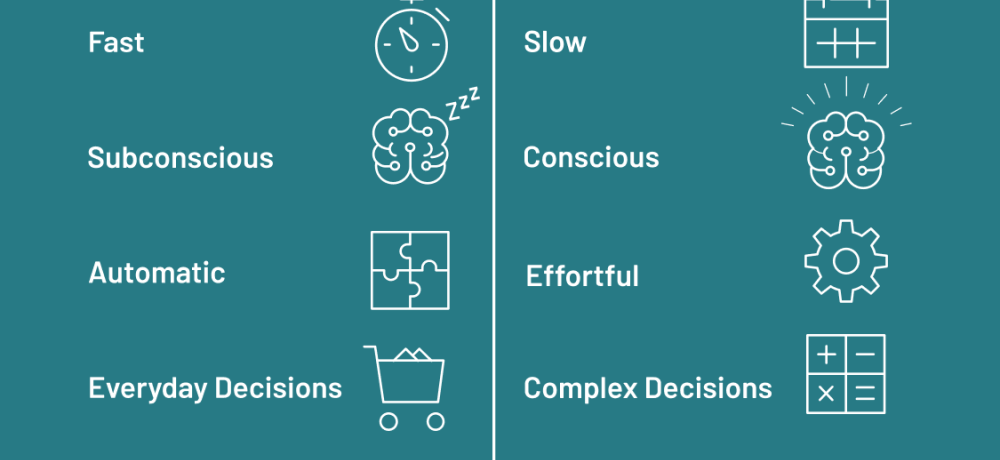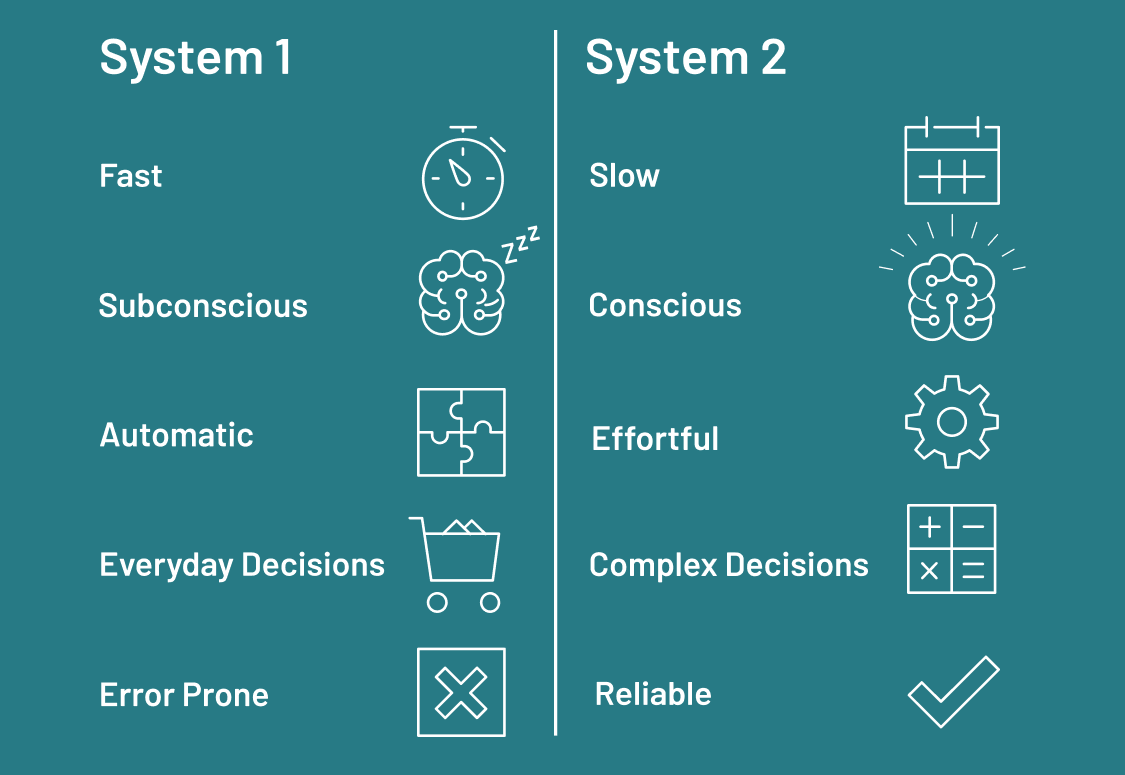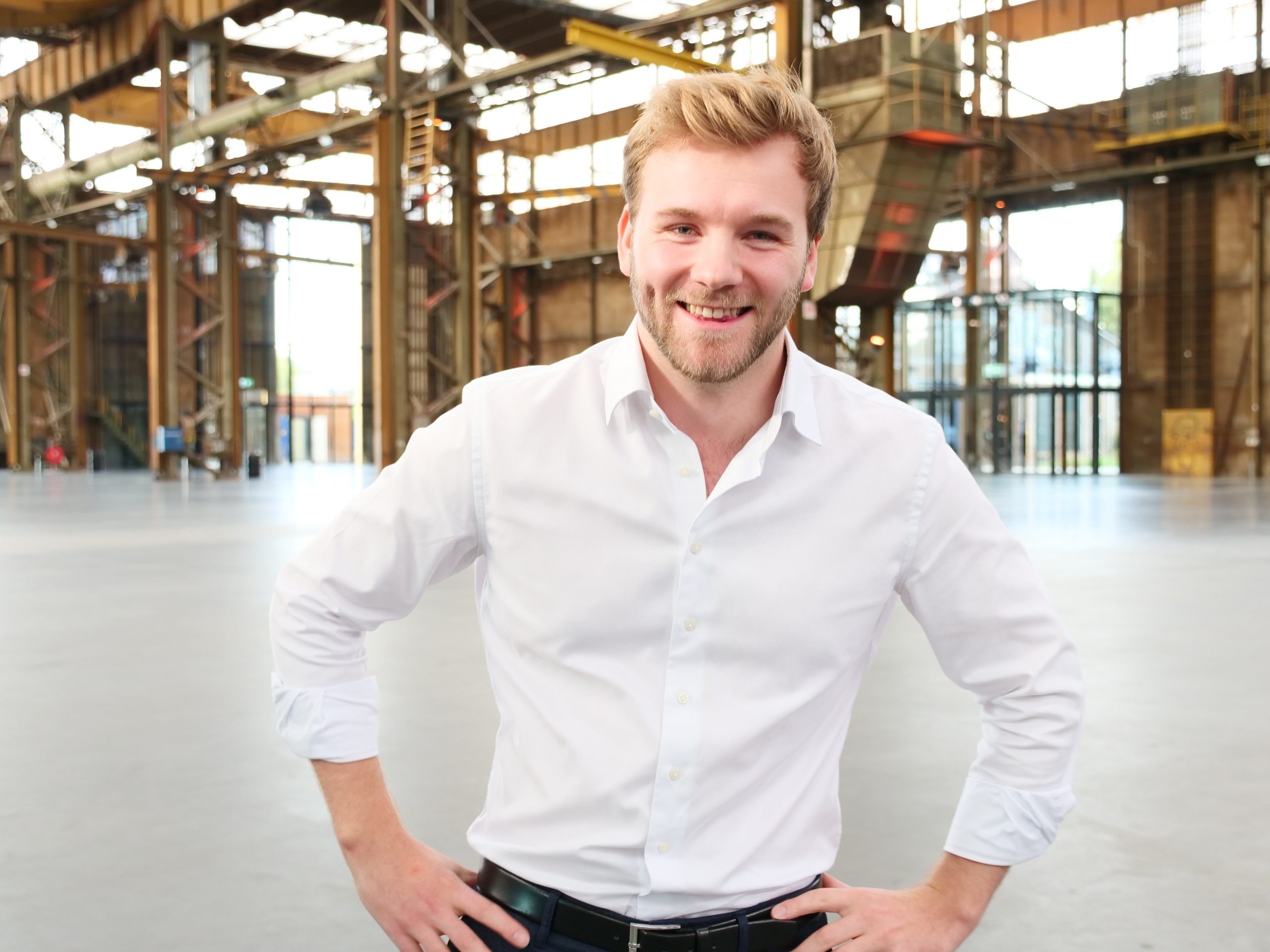
System 1 and 2: Thinking fast? Slow down.
Sooner or later, it becomes clear to us that we humans experience trouble with decision-making from time to time. Although most of us think that we know what is best for us, we consistently and systematically make the same irrational errors. The System 1 and 2 theory explains why.
Look around your house for example. There are probably many unnecessary items laying around, that seemed essential when you bought them. Yet, you never use them. They are only taking up space, but you don’t find yourself throwing them out. Why do we behave this way?

The godfather of behavioral economics
Daniel Kahneman, Nobel-prize winning pioneer in human decision-making and godfather of behavioral economics, showed us what happens. Many errors we make in judging situations and making decisions arise from using heuristics and biases in the decision-making process.
To understand the motivation behind the decisions that we make in our personal and professional life, psychologists and neuroscientist often rely on the division between two systems of thought. Kahneman describes these systems as System 1 and 2.
He differentiates thinking System 1, where the brain acts fast, intuitive and without conscious effort, from System 2, a slower, analytical, and more deliberate way of thinking.
System 1 and 2: The stubborn hero and his skeptical associate
You could view System 1 as a stubborn hero, that does not think twice before acting. But, when push comes to shove, he is there to save the day. System 2 would, in its place, be his skeptical associate, not as fast or inexhaustible as our hero, but often second-guessing his decisions and correcting them at critical moments. While the stubborn hero is always active, his skeptical associate only steps in when necessary to conserve his energy. Very lazy indeed.
System 1: What you see is all there is
System 1 relies on our associative memory. It uses connections between earlier seen words, images, actions, and emotions to form a conclusion and make quick decisions. Even when there is not enough information available to make a rational decision.
System 1 operates via the ‘what you see is all there is’ principle. The only goal is to form a coherent story from the available information at that particular time that motivates a decision. Coherent, however, does not always mean reliable.
To save precious energy, our brain tends to spend as little energy as possible when solving problems and making decisions. However, without analytic and systematic System 2 thinking, we make predictably irrational mistakes.
Both systems have their pros and cons, but when they work together, they form the foundation of our actions, beliefs and decisions. Unfortunately, the collaboration of these systems in your brain does not always run smoothly. If you think your brain is immune to these kinds of errors, just tag along.
Example 1: Attribute substitution
A baseball bat and a ball cost 1.10 euros together. The bat costs a euro more than the ball. So how much does the ball cost?
If you guessed the ball costs 10 cents, your intuitive system 1 thinking is tricking you. If the ball would cost 10 cents, and the baseball bat costs 1.00 euro more than the ball, the bat would cost 1.10. That means that the bat (1.10) and ball (0.10) together would cost you 1.20 euros. The correct answer is that the ball costs 5 cents.
So, what went wrong here? The problem is, although it is relatively easy, harder than it initially looks. Your fast, intuitive System 1 thinking mistook this for a more manageable problem. It substituted “the bat costs 1.00 euro more than the ball” with “the bat costs 1.00 euro”, without you being conscious of it. That is known as attribute substitution.
Example 2: Anchoring
If I were to ask if the average price of German cars was around 100.000 euros, you would find this way too high. However, the high number I mentioned focuses your brain on expensive cars (Audi, BMW).
If I asked you if the average price of the same cars was around 10.000 euros, you would say that this price is too low. But the low-price number would focus your brain on cheaper cars (Volkswagen, Opel).
If you had to come up with an estimate of the average price of German cars by yourself, your answer would differ significantly, depending on whether I provided you with the high anchor (100.00 euros) or the low anchor (10.00).
This cognitive bias is known as anchoring and is used in negations of, for example, salary or the value of an object.
Who is in charge? System 1 and 2
Because of our steadily running System 1 and our lazy System 2, almost no one is resilient to cognitive biases and heuristics when making decisions. Most of us identify ourselves with System 2, but a vast amount of research shows that System 1 is in charge 95% of the time.
It remains up to us to take time for an analytic approach when making decisions, so that we would make fewer mistakes in the process. That is why, especially when taking risks and making important decisions, it is better to think slow.
In our free online course Brain & Behavior for Growth, System 1 and 2 thinking is one of the most fundamental frameworks. When you understand the nuances you’ll see it everywhere, from explaining irrational behavior to recognizing your own decision-making patterns. Understanding how people are likely to act allows you to understand and guide behavior subtly.
With over 200 cognitive biases and every context being unique it can be hard to get started. That’s why we write you this content on insights from behavioral psychology and neuroscience.
If you want to learn more about behavioral insights, read our blog or watch 100+ videos on our YouTube channel!
About Neurofied
Neurofied is a behavioral science company specialized in training, consulting, and change management. We help organizations drive evidence-based and human-centric change with insights and interventions from behavioral psychology and neuroscience. Consider us your behavioral business partner who helps you build behavioral change capabilities internally.
Since 2018, we have trained thousands of professionals and worked with over 100 management, HR, growth, and innovation teams of organizations such as Johnson & Johnson, KPMG, Deloitte, Novo Nordisk, ABN AMRO, and the Dutch government. We are also frequent speakers at universities and conferences.
Our mission is to democratize the value of behavioral science for teams and organizations. If you see any opportunities to collaborate, please contact us here.
